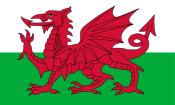Y Fro Gymraeg

Y Fro Gymraeg (literally 'The Welsh Language Area', pronounced [ə vroː ˈɡəmrɑːɨɡ]) is a name often used to refer to the linguistic area in Wales where the Welsh language is used by the majority or a large part of the population; it is the heartland of the Welsh language and comparable in that respect to the Gàidhealtachd of Scotland and Gaeltacht of Ireland. However, unlike its equivalent in Ireland, Y Fro Gymraeg does not at present have official government recognition.
The recognition of a "powerhouse"
The importance of Y Fro Gymraeg powerhouse to the rest of Wales was formulated over a few months by a Bangor college lecturer, Owain Owain in January 1964, when he published in his Tafod y Ddraig magazine a map outlining Y Fro.[1] In an article dated the 12th of November 1964, he wrote: Enillwn y Fro Gymraeg, ac fe enillir Cymru, ac oni enillir Y Fro Gymraeg, nid Cymru a enillir ("We win Y Fro Gymraeg, and Wales will be won, and unless Y Fro Gymraeg is won, it is not Wales that will be won").
This stress on the importance of protecting Y Fro Gymraeg became an important element in the policy of Cymdeithas yr Iaith Gymraeg (the Welsh Language Society) and would later be reflected in the activities of other language movements such as Cymuned.[citation needed]
Areas within Y Fro Gymraeg
A generation or two ago one could say that almost all of western Wales, from Anglesey to parts of Pembrokeshire and Carmarthenshire lay in the Bro, and that it also included significant parts of western Powys and of the old county of Clwyd. But today the territory of the language as a majority language has shrunk. A substantial portion of four Welsh counties lies within Y Fro Gymraeg, which also includes other communities from surrounding counties. The four main counties with a majority of Welsh-speaking inhabitants are Gwynedd, Carmarthenshire (Sir Gaerfyrddin in Welsh), Ceredigion and Anglesey (Ynys Môn), although even in these counties one cannot say that every town and village is a Welsh stronghold. Surrounding areas often included in the Bro, with a significant percentage of Welsh speakers, include parts of Neath Port Talbot (Castell-nedd Port Talbot), parts of western Powys, northern Pembrokeshire (Sir Benfro), the uplands of Conwy, the uplands and countryside of Denbighshire (Sir Ddinbych), Flintshire (Sir y Fflint) and parts of the district of Swansea (Abertawe).
| Part of a series on the |
| Culture of Wales |
|---|
 |
| History |
| People |
|
|
Traditions
|
|
Mythology and folklore |
|
Cuisine
|
|
Festivals |
| Religion |
| Art |
|
Literature
|
|
Music and performing arts |
|
Media
|
|
Education in Y Fro Gymraeg
It is often argued that Welsh medium education is the major contributor to the revival of the language.[citation needed] Education in Y Fro Gymraeg is generally through the medium of Welsh, which accounts for about 70% of the school timetable, on average. Although this is a fairly high figure, some argue that more needs to be done to ensure that all pupils within the region receive their education through the medium of Welsh.[citation needed]
Public services and roadsigns
In Y Fro Gymraeg road signs appear with the Welsh name first. This even occurs in non-predominantly Welsh speaking areas to increase the profile of the language.
Official publications in general are bilingual, usually with Welsh appearing first, within Y Fro Gymraeg because[citation needed] of the increased[citation needed] and evident[citation needed] use of the language in these fields.
See also
- Gàidhealtachd: the Scottish Gaelic speaking areas of Scotland
- Gaeltacht: the Irish speaking areas of Ireland
- List of Welsh principal areas by percentage Welsh language
References
- ↑ (Welsh language) Tafod y Ddraig / The Dragon's Tongue, Vol 4; January 1964
External links
| ||||||||||||||||||||||||||||